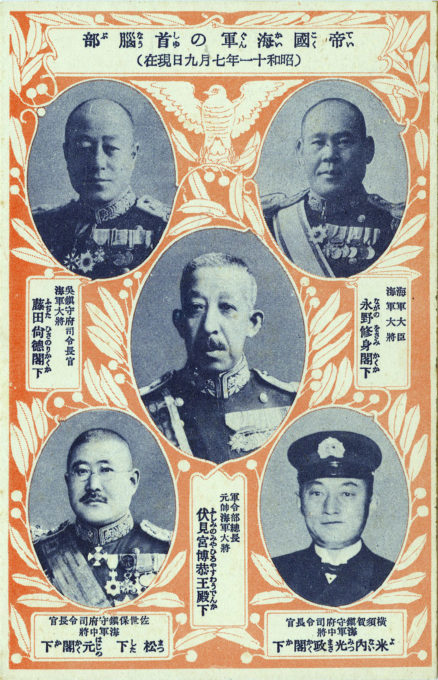
“Our Imperial Navy Brain Trust (Leadership)”, Imperial Japanese Navy General Staff, July 1936 (Showa 11.7.9).
Top row: Admiral Fujita Hisanori (Commander-in-chief Naval Forces); Admiral Nagano Osami (future Navy Minister, future War Council member).
Center: Marshal Admiral Prince Fushimi Nomiya Hiroyasu, Chief of Staff (1932-1941).
Bottom row: Vice Admiral Matsushita Hajime (Commander-in-chief Sasebo Naval Station); Vice Admiral Yonai Mitsumasa (Commander-in-chief Yokosuka Naval Station, future Commander-in-chief Combined Fleet, future Prime Minister 1940).
See also:
Imperial Japanese Navy Fleet Commanders, 1936.
Final Imperial Japanese Navy Fleet Review, 1940.
“The Imperial Japanese Navy General Staff (‘gunreibu’) was the highest organ within the Imperial Japanese Navy. In charge of planning and operations, it was headed by an Admiral headquartered in Tokyo.
“Created in 1893, the Navy General Staff took over operational (as opposed to administrative) authority over the Imperial Japanese Navy from the Navy Ministry. It was responsible for the planning and execution of national defense strategy. Through the Imperial General Headquarters it reported directly to the Emperor, not to the Prime Minister, National Diet or even the Navy Ministry. It was always headed by an admiral on active duty, and was based in Tokyo.
“After the Washington Naval Conference of 1921–22, where Japan agreed to keep the size of its fleet smaller than that of the United Kingdom and the United States, the Imperial Japanese Navy became divided into the mutually hostile ‘Fleet Faction’ and ‘Treaty Faction’ political cliques. The Navy Ministry tended to be pro-Treaty Faction and was anxious to maintain the Anglo-Japanese Alliance. However the Navy General Staff came to be dominated by the Fleet faction, and gradually gained ascendancy in the 1930s with increasing Japanese militarism. It was the Navy General Staff who pushed through plans to attack Pearl Harbor against the wishes of the more diplomatic Navy Ministry.
“After 1937, both the Navy Minister and the Chief of the Navy General Staff were members of the Imperial General Headquarters.”
– Wikipedia
Marshal Admiral Prince Fushimi: (1875–1946) was a scion of the Japanese imperial family and was a career naval officer who served as chief of staff of the Imperial Japanese Navy from 1932 to 1941. As Chief of Staff, he supported the “southward advance” into northern French Indochina and the Dutch East Indies, but expressed reservations about the Tripartite Pact with Germany and Italy.
Admiral Nagano Osami: (1880–1947) was born in Kōchi to an ex-samurai family. In 1900, he graduated from the 28th class of the Imperial Japanese Naval Academy, ranking second in a class of 105 cadets. In 1910, Nagano was promoted to lieutenant commander and assigned as chief gunnery officer on the battleship Katori. From January 1913 to April 1915, he was a language officer in the United States, during which time he studied at Harvard Law School. From December 1920, Nagano was a military attaché to the United States. In this capacity, he attended the Washington Naval Conference. In December 1923, he was promoted to rear admiral.
In 1936, Nagano was appointed Navy Minister under Prime Minister Kōki Hirota. Later in 1937, he became commander-in-chief of the Combined Fleet . By April 1941, he had risen to the very top of the Japanese Navy leadership to become chief of the Imperial Japanese Naval General Staff. A staunch believer in Nanshin-ron [“Southern Advance”], he played a central role in Japan’s decision to go to war with the United States. It was Nagano who informed Emperor Hirohito that Japan’s oil supply would run out in two years if the embargo was not lifted. Consequently, Nagano advised that the country should be ready for war within that time frame if attempts at diplomacy failed.
Nagano initially opposed Admiral Isoroku Yamamoto’s planned attack on Pearl Harbor, but reluctantly gave his approval for the attack after Yamamoto threatened to resign as Combined Fleet commander.
In 1943, Nagano was promoted to Marshal Admiral. By 1944, however, Japan had suffered serious military setbacks and Nagano had lost the confidence of Emperor Hirohito. With the emperor’s approval, Nagano was removed from his postings but spent the remainder of the war as an advisor to the government.
Vice Admiral Yonai Mitsumasa: (1880–1948) was an admiral in the Imperial Japanese Navy, Minister of the Navy, and served as the Prime Minister of Japan in 1940. He graduated from the 29th class Imperial Japanese Naval Academy in 1901. Yonai was given command of the IJN 3rd Fleet in December 1932, following which he again commanded the Sasebo Naval District (November 1933), IJN 2nd Fleet (November 1934) and Yokosuka Naval District (December 1935) before receiving appointment as Commander-in-Chief of the Combined Fleet and concurrently the IJN 1st Fleet in December 1936.
Yonai became full admiral in April 1937 and Navy Minister in the cabinet of Prime Minister Senjūrō Hayashi in 1937. As Navy Minister, Yonai was alarmed by the growing tension between Japan and Great Britain and the United States, at a time when the bulk of the Imperial Japanese Army was tied down in an apparently unending quagmire in China. His efforts to promote peace made him unpopular with ultranationalist extremists, and (as with Admiral Isoroku Yamamoto) he was the target of several assassination attempts.
Yonai was appointed Prime Minister of Japan from January 6, 1940, largely with the backing of Emperor Hirohito. As Prime Minister, he continued the strong pro-British, pro-American stance he held as Navy Minister and continued his strong opposition to the Tripartite Pact with Nazi Germany and fascist Italy. Yonai was subsequently forced to resign on July 21, 1940, ostensibly because of his anti-German views.
Serving again as Navy Minister from 1944, Yonai, in the last few weeks before Japan’s surrender in 1945, sided with Prime Minister Suzuki and Foreign Minister Shigenori Tōgō in support of acceptance of the Potsdam Declaration.

